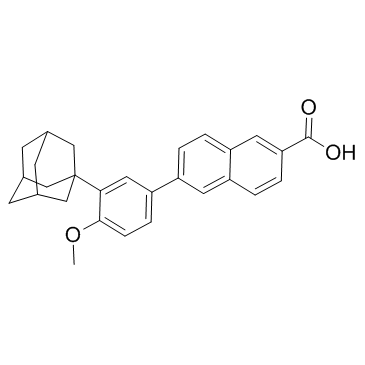Adapalene

Adapalene structure
|
Common Name | Adapalene | ||
|---|---|---|---|---|
| CAS Number | 106685-40-9 | Molecular Weight | 412.520 | |
| Density | 1.2±0.1 g/cm3 | Boiling Point | 606.3±55.0 °C at 760 mmHg | |
| Molecular Formula | C28H28O3 | Melting Point | 319-322ºC | |
| MSDS | Chinese USA | Flash Point | 205.9±25.0 °C | |
|
Comparison of rheological properties, follicular penetration, drug release, and permeation behavior of a novel topical drug delivery system and a conventional cream.
Eur. J. Pharm. Biopharm. 88(3) , 614-24, (2015) A novel adapalene-loaded solid lipid microparticle (SLMA) dispersion as a topical drug delivery system (TDDS) for follicular penetration has been introduced. The objective of the present study was to investigate the rheological properties, the follicular pene... |
|
|
Impaired aldehyde dehydrogenase 1 subfamily member 2A-dependent retinoic acid signaling is related with a mesenchymal-like phenotype and an unfavorable prognosis of head and neck squamous cell carcinoma.
Mol. Cancer 14(1) , 204, (2015) An inverse correlation between expression of the aldehyde dehydrogenase 1 subfamily A2 (ALDH1A2) and gene promoter methylation has been identified as a common feature of oropharyngeal squamous cell carcinoma (OPSCC). Moreover, low ALDH1A2 expression was assoc... |
|
|
Origins of the breast milk-derived cells; an endeavor to find the cell sources.
Cell Biol. Int. 39(5) , 611-8, (2015) Fresh human breast milk consists of a heterogeneous population of cells that may offer a non-invasive source of cells for therapeutic proposes. The aims of this study were to characterize the breast milk-derived cells cultured in vitro. To do this, the cells ... |
|
|
Evaluation of retinoids for induction of the redundant gene ABCD2 as an alternative treatment option in X-linked adrenoleukodystrophy.
PLoS ONE 9(7) , e103742, (2014) X-linked adrenoleukodystrophy (X-ALD), the most common peroxisomal disorder, is a clinically heterogeneous disease that can manifest as devastating inflammatory cerebral demyelination (CALD) leading to death of affected males. Currently, the only curative tre... |
|
|
Retinoids and rexinoids inhibit hepatitis C virus independently of retinoid receptor signaling.
Microbes Infect. 16(2) , 114-22, (2014) Using a high-throughput screening system involving HCV JFH-1-Huh 7.5.1 cells, we determined that the ligands of class II nuclear receptors, retinoids and rexinoids inhibit HCV infection. Retinoids, ligands of retinoic acid receptor (RAR), and rexinoids, ligan... |
|
|
Tazarotene versus tretinoin or adapalene in the treatment of acne vulgaris.
J. Am. Acad. Dermatol. 43(2 Pt 3) , S51-4, (2000) The efficacy and tolerability of tazarotene 0.1% gel in the treatment of acne vulgaris have been compared with those of tretinoin 0.025% gel and adapalene 0.1% gel in multicenter, double-blind, randomized, parallel-group trials. Preliminary results from the t... |
|
|
Topical tretinoin or adapalene in acne vulgaris: an overview.
J. Dermatolog. Treat. 15(4) , 200-7, (2004) Retinoids target several pathoetiologic events of acne vulgaris. The undisputed efficacy of tretinoin, and yet its underutilization, due to apprehension of retinoid dermatitis, triggered a search for newer, well-tolerated retinoids. The discovery of nuclear r... |
|
|
Epiduo (adapalene 0.1% and benzoyl peroxide 2.5%) approval in children 9 years and older.
Skinmed 11(5) , 295-6, (2013)
|
|
|
Adapalene 0.1% and benzoyl peroxide 2.5%: a novel combination for treatment of acne vulgaris.
Skin Therapy Lett. 14(6) , 4-5, (2009) Topical products commonly used to treat acne include retinoids and antimicrobials, due to their effects on different components of pathogenesis. Accordingly, a fixed combination of adapalene 0.1% and benzoyl peroxide (BPO) 2.5% was developed (Epiduo, Galderma... |
|
|
Adapalene 0.1%/benzoyl peroxide 2.5% gel: a review of its use in the treatment of acne vulgaris in patients aged ≥ 12 years.
Am. J. Clin. Dermatol. 12(6) , 407-20, (2011) Adapalene 0.1%/benzoyl peroxide 2.5% gel (Epiduo™, Tactuo™) is the only fixed-dose combination product available that combines a topical retinoid with benzoyl peroxide; it targets three of the four main pathophysiologic factors in acne. This article reviews t... |